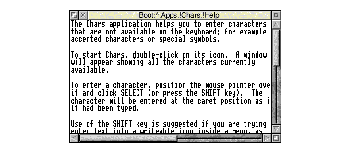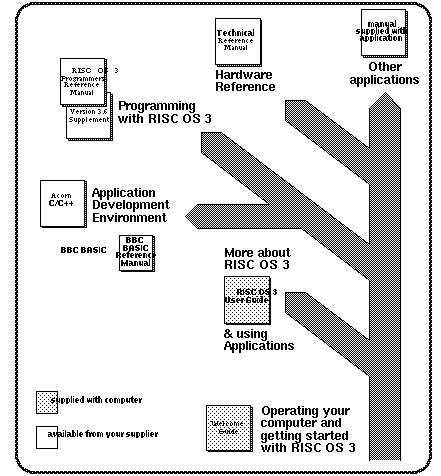




RISC OS 3.7 User Guide
Introduction
This guide, in conjunction with your Welcome Guide, describes the RISC OS 3 operating system.
If you are new to your computer, you should first read the Welcome Guide, which tells you how to set it up and start using it. This guide sometimes assumes your computer has a hard disc. If you're using a network machine, your network administrator or IT coordinator will help you out.
About this guide
If you have read the Welcome Guide, you should already have a working knowledge of the desktop. This guide builds on that knowledge.
The first eight chapters (up to Networking) start out by recapping on what you learnt in the Welcome Guide, and tells you more about manipulating files, directories and applications. It shows you how to use the Filer and the Pinboard, and how to select the colours and resolutions used on the desktop. There's information on changing the way the desktop behaves and changing the start-up procedure so that the most frequently-used applications are started automatically. There's also help if things go wrong. Finally there's a description of ADFS, Networks and other filing systems.
The next five chapters tell you how to set up your printer correctly, and how to configure your printer to make the most of the computer's capabilities.
RISC OS applications (Chapter 14) introduces you to the applications supplied with your computer, and describes how to use different colours and fonts. It gives tutorial information on how to use the painting, drawing and editing applications, and follows this with detailed reference material about all the other RISC OS applications (with the exception of those concerned with printing, dealt with earlier).
The Appendices tell you about the Command Line Interface. This provides you with an additional way of communicating with the computer, one which programmers and experienced users will find especially useful. They also contain reference material on subjects such as BBC BASIC, file-types, character sets and error messages.
At the end you'll find the RISC OS end-user licence conditions .
The RISC OS operating system
RISC OS stands for Reduced Instruction Set Computer Operating System. RISC OS consists of three layers:
- The core, containing the programs that actually make the computer work.
- The command line interface, which is a text-based interface used to write programs and scripts. Most people never need to use the command line.
- The desktop, which is the outermost layer . This manual is mostly about the desktop, which uses icons to represent files, directories and applications, and runs applications in windows. You can have many windows on the screen at once.
RISC OS allows you to load an application from a disc, for example, and then determines how that program is run, using your input from the mouse and keyboard. When you've finished, it lets you save your work back to a disc, in a file.
Conventions used in this manual
The following conventions are used in this guide:
Mouse techniques
Usually you'll perform the following techniques with the Select (lefthand) mouse button, unless instructed otherwise in the text:
- clicking - pressing a button just once and then releasing it immediately.
- double-clicking - pressing and releasing twice in quick succession. This is most commonly used to load an application.
- dragging - moving an object from one place to another whilst holding down the Select (or Adjust) button.
Often, you'll be told to Press Menu over an object. This means move the pointer over the object and press the Menu button.
Menu names and options are shown in bold type. The path you need to take through a series of submenus to reach an option is described like this:

Other conventions
- Often you'll be told to 'press Return' (to enter a command, or confirm an action). This is the key marked with the bent arrow
- The Shift key is marked with this symbol:

- Sometimes you will need to press one key while holding down another. For example, 'Press Ctrl-F9' means hold down the Control (Ctrl) key and press the function key F9.
Important tips
Before using your computer, you should read the Guidelines for safe operation printed near the front of your Welcome Guide.
Freeing up more disc space
If you require more hard disc space, you can free up space by deleting directories that you don't often use, such as the Video, Images and Sound directories. Before deleting them, you should always take a backup of any files, directories or applications that you may wish to keep (see Backing up discs on page 81). The Welcome Guide shows you how to delete files and directories.
If your computer halts at the command line when you switch it on (the screen is blank except for a * prompt and a flashing cursor), it may be because your hard disc is full. Type *Desktop to display the desktop. Free up some space on your disc then reboot the computer.
Unexpected behaviour
If your computer starts behaving unexpectedly, or doesn't do anything at all, see If things go wrong in the Welcome Guide. This has solutions to most common problems.
If the screen goes blank
If your screen goes blank while you are not using it, it's probably because the screenblanker has automatically switched off the display to save electricity and wear on the screen. You can restore the display by moving the mouse or pressing any key on the keyboard (e.g. the Shift key).
Getting out of a mess (resetting the computer)
Very occasionally your computer may 'hang up' - where pressing a key or mouse button has no effect. You can normally cure this by resetting the computer. To do this, first try pressing Alt-Break or, if that fails, Ctrl-Break. If this fails, press the Reset button. Your Welcome Guide shows you where this is. Alternatively, turn the computer off, wait a short while (30 seconds) and turn on again. When you reset the computer, any unsaved data is lost. For more information about resetting your computer refer to Troubleshooting on page 71.
Getting help
The !Help application
 The !Help application provides on-screen information as you use your computer. You can use this to get help on the desktop and most applications. For information refer to Help on page 357.
The !Help application provides on-screen information as you use your computer. You can use this to get help on the desktop and most applications. For information refer to Help on page 357.
This is what a typical help message looks like:

The Help option on the Filer menu
You can get help on some applications by clicking Menu over an application's icon in a directory display and choosing App./Help. For example, here is the help text for the !Chars application (for more information, see Information and help on page 13).
Additional products and documentation
To support Acorn computers, your supplier should have the following products available:
- Xemplar Product Directory: A catalogue of hardware and software products for Acorn computers.
- BBC BASIC Reference Manual: A reference manual for BBC BASIC V and VI. The BBC BASIC programming language is provided with RISC OS. If you plan to write BASIC programs on your Acorn computer, you will find the BBC BASIC Reference Manual invaluable.
- RISC OS 3 Programmer's Reference Manual: A four-volume reference manual for the RISC OS 3 operating system. Essential reading for all serious RISC OS programmers. This set also includes the RISC OS Style Guide. This sets out any user interface design guidelines you should follow.
- RISC OS 3 Programmer's Reference Manual Volume 5a - Supplement for Versions 3.5 and 3.6: A special programmer's supplement for the RISC OS 3, Version 3.6 operating system that is used in this computer.
- Technical Reference Manuals: These are available for most RISC OS computers. They give the technical specifications of all interfaces used in the computer. These manuals are essential if you are developing hardware add-ons and enhancements for the computer.
- Acorn C/C++: If you are developing desktop applications, you'll need Acorn's Application Development Environment. This contains Application Development software, along with the Desktop C, C++ and Desktop Assembler languages.
Documentation roadmap
This roadmap shows you some of the tools and manuals that are available to help you get more out of your computer.
RISC OS 3.7 User Guide - 21 JAN 1997




